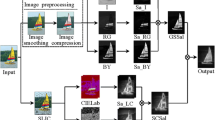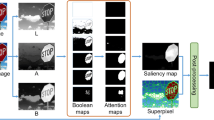Abstract
Traditional saliency detection methods are designed only for a single salient object and cannot detect multiple salient objects in the image. This paper proposes a novel method for detecting multiple salient objects in the image, which is based on both objectness estimation method and superpixel segmentation method. The present study shows that the proposed method can correctly detect the salient regions for multiple objects and outperforms the other three state-of-the-art saliency detection methods.









Similar content being viewed by others
References
Achanta R, Susstrunk S (2010) Saliency detection using maximum symmetric surround. IEEE Int Conf Image Process 119(5):2653–2656
Achanta R, Shaji A, Smith K (2012) SLIC superpixels compared to State-of-the-Art superpixel methods. IEEE Trans Pattern Anal Mach Intell 34(11):2274–2281
Alexe B, Deselaers T, Ferrari V (2010) What is an object. Comput Vis Pattern Recognit 23(3):73–80
Borji A, Cheng M-M, Hou Q, Jiang H, Li J (2014) Salient object detection: a survey. Eprint Arxiv 16(7):3118
Bruce N, Tsotsos JK (2005) Saliency based on information maximization. Int Conf Neural Inf Proces Syst 18(3):155–162
Cheng MM, Zhang ZM, Lin WY, Torr P (2014) BING: binarized normed gradients for objectness estimation at 300fps. 2017 I.E. conference on computer vision and pattern recognition, CVPR 2017. pp 3286–3293
Cheng MM, Zhang GX, Mitra NJ, Huang X, Hu SM (2015) J. Global contrast based salient region detection. IEEE Trans Pattern Anal Mach Intell 37(3):569–582
Everingham M, Van Gool L, Williams CK, Winn J, Zisserman A (2010) The PASCAL visual object classes (voc) challenge. Int J Comput Vis 88(2):303–338
Everingham M, Eslami SMA, Van Gool L, Williams CKI, Winn J, Zisserman A (2015) The PASCAL visual object classes challenge: a retrospective. Int J Comput Vis 111(1):98–136
Huaizu JJ, Jingdong W, Zejian Y, Yang W, Nanning Z, Shipeng L(2013) Salient object detection: a discriminative regional feature integration approach. Comput Vis Pattern Recognit 123(2):2083–2090
Klein D, Frintrop S (2011) Center-surround divergence of features tatistics for salient object detection. IEEE Int Conf Comput Vis 50(2):2214–2219
Kootstra G, de Boer B, Schomaker L (2011) Predicting eyes on complex visual stimuli using local symmetry. Cogn Comput 3(1):223–240
Oh K, Lee M, Kim G, Kim S (2016) Detection of multiple salient objects through the integration of estimated foreground clues. Image Vis Comput 54:31–44
Oh K-h, Kim S-H, Kim Y-C, Lee Y-R (2016) Detection of multiple salient objects by categorizing regional features. KSII Trans Internet and Inf Syst 10(1):272–287
Rahtu E, Kannala J, Salo M (2010) Segmenting salient objects from images and videos. Eur Conf Comput Vis 6315:366–379
Rosin PL (2009) A simplemethod for detecting salient regions. J Pattern Recognit 42(11):2363–2371
Rother C, Kolmogorov V, Blake A (2004) "GrabCut" - Interactive foreground extraction using iterated graph cuts. ACM Trans Graph 23(3):309–314
Shi J, Yan Q, Xu L, Jia J (2014) Hierarchical image saliency detection on extended CSSD. IEEE Trans Pattern Anal Mach Intell 38(4):717–729
Yongdong Z, Zhendong M, Jintao L, Qi T (2014) Salient region detection for complex background images using integrated features. J Inf Sci 281:586–600
Acknowledgments
This research is supported by the National Natural Science Foundation of China (61662057, 61672143, U1435216), the Fundamental Research Funds for the Central Universities (N130404027, N151704004, N161602003), and Doctor Research Starting Foundation of Liaoning (No.20141011).
Author information
Authors and Affiliations
Corresponding author
Rights and permissions
About this article
Cite this article
Wang, B., Meng, L. & Song, J. Image saliency detection for multiple objects. Multimed Tools Appl 78, 5329–5343 (2019). https://doi.org/10.1007/s11042-018-5731-0
Received:
Revised:
Accepted:
Published:
Issue Date:
DOI: https://doi.org/10.1007/s11042-018-5731-0




